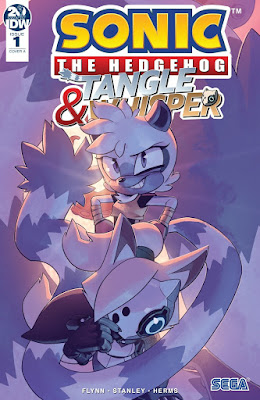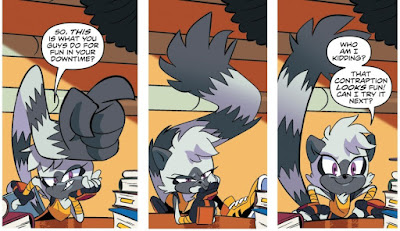Sonic the Hedgehog (IDW): Issue 21
Publication Date: October 2, 2019
Something that’s starting to disappointment about the Metal Virus saga is that it’s so urban thus far. Just going from the games, Sonic’s world is one full of diverse locations. We are talking dessert, beaches, mountains, polar icecaps, enormous casinos, etc. instead of dropping a Zombot horde into the surreal spiraling landscape of the Green Hill Zone, the saga has mostly been content to display the Mecha-zombies overtaking various, nearly identical looking cities. I get this, from a narrative perspective. Eggman is focusing on densely populated areas, to spread the Infection more. That’s where the most people, that need protecting by the good guys, are gathered. But, as issue twenty-one touches upon the exact same set-up as the last few issues, it’s starting to get boring.
This is “The Last Minute, Part One.” The city — that looks like all the other cities — this time is Central City. That’s where Tails’ workshop is located. Eggman jizzes another dollop of grey goop from his Faceship and soon the city is overrun with Zombots. As the zombies spread, Tails toils away in his laboratory on a cure. He finally cracks a cure but just as the infected make it inside, forcing a speedy retreat that looses him his research. Tangle and Whisper also arrive to do what they can, save people, and contain the outbreak. But soon another city has fallen to the shiny tide.
You might notice that synopsis above doesn’t mention Sonic at all. Yes, Flynn gives the titular hero a break in this one. He’s out running as fast as he can, providing Tails with the data needed to engineer a cure, and only appears in one panel. So Tails, Tangle and Whisper are our heroes this time. That’s kind of cool. Even if this zombie outbreak is getting increasingly same-y, it is sort of cool that Flynn is giving us peeks at other corners of the world during this apocalyptic time. Now how about we see what the fuck Knuckles and Angel Island are doing during all of this, Ian? Just standing back and watching his friends suffer?
Anyway, this issue also has Flynn returning to one of his more peculiar characterization. That of Tails as a hyper-capable bad-ass. After the Zombots break in to his workshop and smash the hard drive containing the newly designed cure, Tails jumps into the Tornado 2 from “Sonic Adventure 2.” Instead of using this airplane to, ya know, fly above the encroaching zombie masses, Tails blasts his way out with machine guns and races through the city streets. He then has to self-destruct, tearfully one must add, to make his final escape. On one hand, I guess this makes sense. (Tails being an action hero, not Flynn’s insistence and adding a shoot-out and car chase to this issue.) He can fly, is as fast as Sonic, and also a super-smart engineer. But does someone who talks to his airplane/car/death-bot like it’s a person and cries when he abandons it also need to be a super-cool hero? Isn’t this kid like ten?
Despite potentially being an intimate story about what folks are doing to survive during the zombie outbreak, “The Last Minute” mostly exist to further push the plot ahead. Tails might loose his research but that he invented a cure once suggests he can probably do it again. Meanwhile, a sequence in the middle of the book has Starline recruiting the Deadly Six, in his plan to take control of the Zombots behind Eggman’s back. The Zetis, of course, plan on betraying him as soon as possible. It’s all machinations to move this arc into its next phase. Which is fine but I do wish Flynn had saved room for a little more character interaction, considering these events are so heated, instead of focusing mostly on plot and action.
While I’ve overall applauded the darker direction this comic has taken in 2019, I’m starting to get a little exhausted with this increasingly dire situation. Tails has a cure in his grasp but then it’s yanked away at the last minute. He’s rescued by Amy Rose and an airship, only to learn that Restoration HQ has fallen. (The events of which will be depicted in the next issue.) Maybe only one or the other should’ve happened. This is starting to feel less like natural story developments and more like contrivances to keep the plot, that should be heading into its last act by now, going on longer. Considering we already know the Metal Virus arc will last into the next year, the 25th issue, that’s really what I’m expecting.
Another odd thing about issue 21 is that the art situation. I recently learned that Tracy Yardley will be taking an extended break from the “Sonic” books. This required a last minute artist change for this issue... Or artists change, I should say. Three people had to be brought in to make up for Yardley’s sudden absence. Archie vet Lamar Wells teams with someone named Reggie Graham to pencil the first ten pages. Wells and Graham do fine, though their work isn’t as kinetic as what we’ve gotten use to. The action is slightly stiffer and characters aren’t as expressive, with weirdly thick lines. Jennifer Hernandez handles most of the rest of the book, her work having slightly more personable faces. (Tails’ reaction to the Zombots getting into his workshop is funny.) Weirdly, two random pages — depicting Tails’ escape and the Tornado blowing up — are handled by Priscilla Tramontano, who has mostly done covers up to this point. Tramontano’s work is slightly looser than Hernandez or Wells but also a little more dynamic, which might be a fair trade-off.
So I think it’s fair to say the Metal Virus saga is officially in a rut now. Instead of exploring the horror and tension inherent in the zombie outbreak situation, Flynn has fallen back on repetitive plotting and action. With some questionable plotting decisions, issue 21 is maybe the weakest edition to the arc yet. [5/10]























































